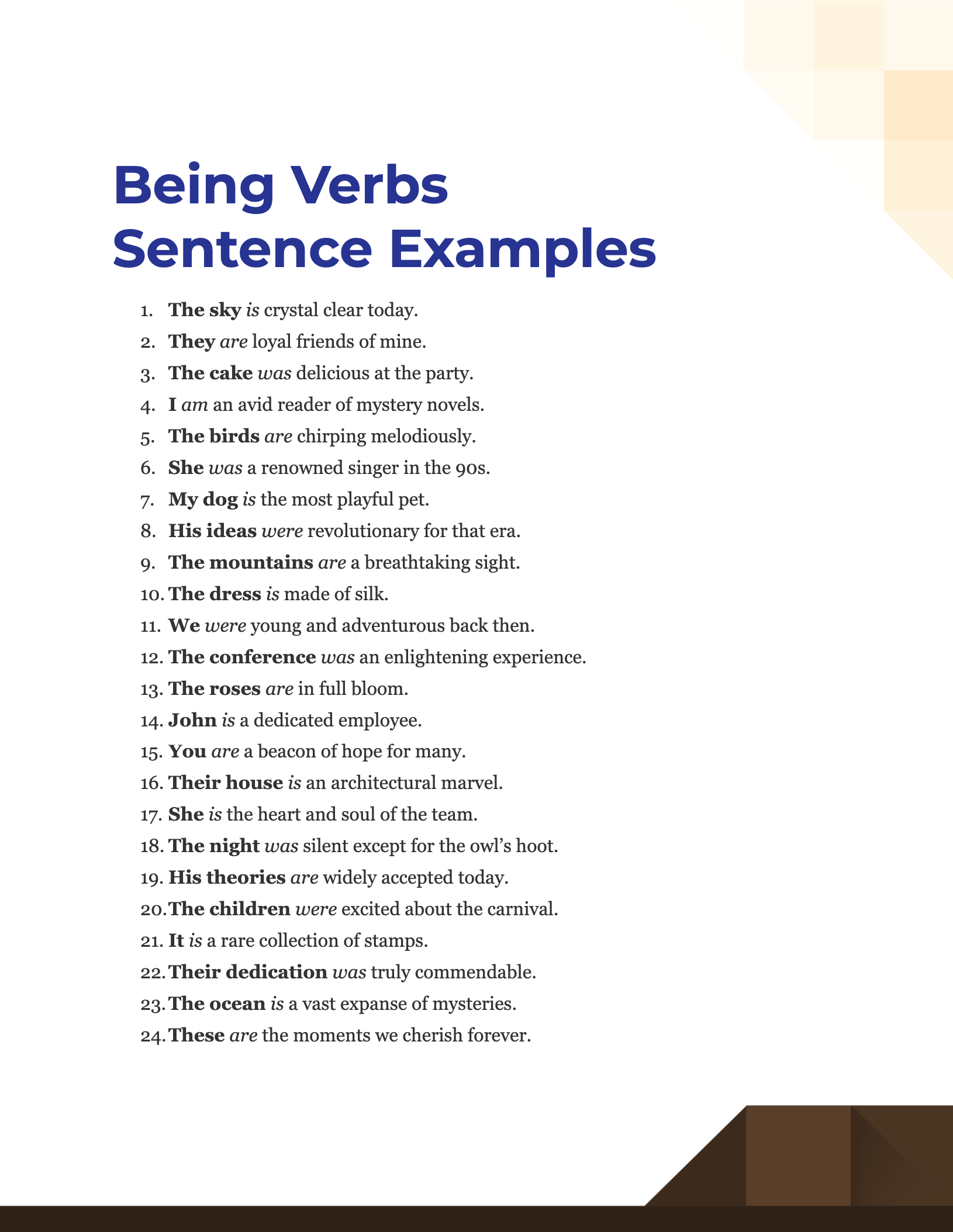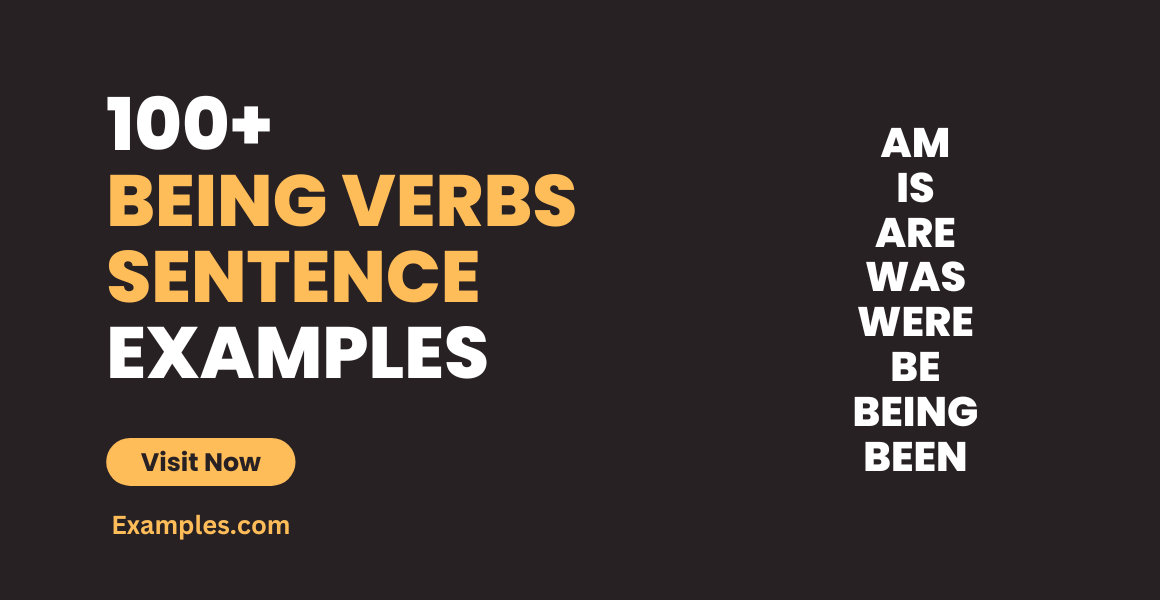99+ Being Verbs Sentence Examples
Dive into the world of being verbs, the unsung heroes that give depth and dimension to our sentences. Whether you’re a budding writer or an English enthusiast, understanding the role and mastery of being verbs can elevate your linguistic prowess. Explore captivating examples, comprehensive guidelines, and nifty tips to seamlessly incorporate being verbs into your writing arsenal.
What is the Being Verbs Sentence? – Definition
Being verbs, often referred to as “linking verbs,” connect the subject of a sentence to a subject complement, such as a noun or an adjective. They describe a state of existence or being. Common being verbs include “am,” “is,” “are,” “was,” and “were,” among others.
What is the best Example of a Being Verbs Sentence?
Consider the sentence: “She is a talented artist.” Here, the being verb “is” connects the subject “She” to the subject complement “a talented artist.” The verb does not indicate any action but instead describes a state of existence, emphasizing her identity as an artist.
100 Being Verbs Sentence Examples

Being verbs, the linchpins of English grammar, seamlessly bridge subjects with their attributes or states, creating vivid imagery or declarations. These verbs, integral to clear communication, often underpin our daily expressions. Immerse yourself in a selection of sentences enriched by being verbs, revealing their quintessential role in shaping eloquence and clarity in language.
- The sky is crystal clear today.
- They are loyal friends of mine.
- The cake was delicious at the party.
- I am an avid reader of mystery novels.
- The birds are chirping melodiously.
- She was a renowned singer in the 90s.
- My dog is the most playful pet.
- His ideas were revolutionary for that era.
- The mountains are a breathtaking sight.
- The dress is made of silk.
- We were young and adventurous back then.
- The conference was an enlightening experience.
- The roses are in full bloom.
- John is a dedicated employee.
- You are a beacon of hope for many.
- Their house is an architectural marvel.
- She is the heart and soul of the team.
- The night was silent except for the owl’s hoot.
- His theories are widely accepted today.
- The children were excited about the carnival.
- It is a rare collection of stamps.
- Their dedication was truly commendable.
- The ocean is a vast expanse of mysteries.
- These are the moments we cherish forever.
- He was an embodiment of kindness.
- The pie is fresh out of the oven.
- The town is known for its festive celebrations.
- Maria is a pillar of strength in tough times.
- Those were the best days of our lives.
- The novel is a gripping tale of suspense.
- Your suggestions were truly valuable.
- The garden is a haven for butterflies.
- This is the best version of the software.
- Her voice was soothing and melodious.
- They are the future leaders of our country.
- The soup is piping hot.
- The story was an emotional roller coaster.
- My dream is to travel the world.
- Your gift was thoughtful and heartwarming.
- His arguments are always well-structured.
- That is the monument we visited last summer.
- Their traditions were passed down generations.
- The forest is home to myriad species.
- The meal is ready to be served.
- The legends were tales of valor and honor.
- Her performance is the highlight of the evening.
- The kitten is the cutest thing ever.
- Their endeavors were path-breaking.
- The atmosphere is electric with anticipation.
- This is the best day of my life.
- The documentary is both informative and inspiring.
- Their village was nestled between two hills.
- He is a beacon of wisdom in trying times.
- The innovations are groundbreaking for the industry.
- The painting was an epitome of artistry.
- The pie is bursting with flavors.
- The marathon was a test of endurance.
- Her approach is unique and effective.
- The solutions were innovative and sustainable.
- The moonlight is casting a silvery glow.
- The meeting was productive and conclusive.
- His vision is transformative for the community.
- The rituals were symbolic and profound.
- This is a crucial juncture for the company.
- Her articles are insightful and well-researched.
- The weather is surprisingly pleasant for summer.
- The ceremony was steeped in tradition.
- His strategies are game-changers for the market.
- The workshop was interactive and enlightening.
- The sculpture is a marvel of craftsmanship.
- Their journey was filled with challenges and triumphs.
- The texture is smooth and creamy.
- Her presence was always reassuring.
- The techniques are advanced and efficient.
- The aroma is enticing and aromatic.
- The discussions were fruitful and engaging.
- The landscape is a blend of nature and architecture.
- His skills are unparalleled and impressive.
- The experience was surreal and unforgettable.
- The design is both functional and aesthetic.
- The festival was a medley of cultures and traditions.
- The discoveries are pivotal for scientific advancements.
- The camp was set up beside the tranquil lake.
- The curriculum is comprehensive and holistic.
- Their bond was deep and unbreakable.
- The dessert is the perfect balance of sweet and savory.
- His insights were visionary and forward-thinking.
- The forest trail is an adventurer’s paradise.
- The project was accomplished ahead of schedule.
- Her dedication is commendable and unwavering.
- The concert was a musical extravaganza.
- The results are promising and encouraging.
- The sunset is a riot of colors.
- The initiative was impactful and widespread.
- The fabric is soft and durable.
- The feedback was constructive and beneficial.
- The lake is crystal clear and serene.
- His achievements are noteworthy and significant.
- The show was a hit among all age groups.
- The solutions are tailored to individual needs.
Each of these sentences vividly showcases the role of being verbs in anchoring the subject to its complement, painting a vivid picture or making a firm statement. Incorporating being verbs effectively in your sentences can enrich the quality of your communication, offering clarity and depth in equal measure.
What are the 8 being verbs?
Being verbs, often referred to as “linking verbs” or “state of being verbs,” serve as essential connectors in the English language. They link the subject of a sentence to either a noun that renames the subject or an adjective that describes the subject. The primary being verbs are derived from the verb “to be.” Here are the eight fundamental being verbs:
- am
- is
- are
- was
- were
- be
- being
- been
It’s crucial to understand that these verbs can function outside of their “being” verb role. For instance, “been” can be used as a helping verb, as in “She has been running.”
How do you use a being verb in a sentence?
Using being verbs can enhance clarity and structure in your sentences. Here’s a guide on how to effectively use them:
- Identifying the Subject: The sentence’s subject will determine which form of the being verb you should use. For example:
- Singular subjects (like “he” or “she”) often use “is”: He is a talented musician.
- Plural subjects (like “they” or “we”) often use “are”: They are at the concert.
- Connecting to Nouns or Adjectives: Being verbs connect the subject to either a noun or an adjective.
- Noun: The dog is a golden retriever.
- Adjective: The dog is friendly.
- Describing a Past State: Use “was” or “were” to discuss a state or condition in the past.
- Singular: She was a teacher.
- Plural: They were students.
- Talking About Ongoing Actions: Use “being” when discussing an action that was, is, or will be ongoing.
- The house is being painted.
- The play was being rehearsed when I arrived.
- Referring to Experiences: Use “been” to talk about experiences or actions that have happened at an unspecified time in the past.
- She has been to Paris several times.
- I’ve been reading for hours.
- Avoiding Redundancy: Ensure you’re not using being verbs redundantly. For instance, instead of saying “He is being annoying,” it’s clearer to say, “He is annoying.”
- Practice & Review: The more you practice using being verbs in sentences, the more intuitive it becomes. It’s also a good idea to review your sentences to ensure that the being verb used is the most appropriate for the context.
Incorporating being verbs in your sentences gives them a structure that facilitates clarity. Recognizing and mastering their use can significantly enhance the flow and coherence of your writing and communication.
How do you write a Being Verbs Sentence? – Step by Step Guide
Being verbs, often referred to as linking or auxiliary verbs, serve a unique purpose in English language construction. Their primary role is to connect the subject of a sentence to its complement. Here’s a structured guide to crafting sentences with being verbs:
- Choose Your Subject: Every sentence needs a subject, the main noun about which something is being said. For instance, “The apple…”
- Select a Being Verb: Common being verbs include “is,” “am,” “are,” “was,” and “were.” The choice depends on the subject’s number (singular/plural) and tense (present/past). For our example, “The apple is…”
- Determine the Complement: The complement provides more information about the subject. It can be a noun, pronoun, adjective, or even a phrase. Continuing our example, “The apple is red.”
- Enhance with Modifiers: Add adjectives, adverbs, or phrases to make the sentence more descriptive. “The apple is bright red and juicy.”
- Check for Agreement: Ensure that your being verb aligns with the subject in terms of number and tense. For instance, “The apples are…” instead of “The apples is…”
- Review for Clarity: Once composed, reread your sentence to ensure it’s clear and conveys the intended message.
- Practice with Different Subjects and Complements: Regularly crafting sentences with varied subjects and complements will reinforce your understanding of being verbs.
Tips for Using Being Verbs Sentences
Being verbs sentences are indispensable in English, offering nuance and depth. To effectively incorporate them into your writing:
- Limit Redundancy: While being verbs are crucial, overusing them can lead to passive or redundant sentences. Aim for a balance between action verbs and being verbs.
- Context Matters: Use being verbs judiciously based on the context. For instance, in descriptive passages, being verbs might be more appropriate, while action scenes might require more dynamic verbs.
- Choose the Correct Being Verb: Make sure to pick the being verb that aligns with your subject in terms of number (singular/plural) and tense (present/past).
- Stay Active: When possible, structure your sentence in the active voice. Passive constructions often employ being verbs and can sometimes muddle the message.
- Enhance with Descriptive Complements: Since being verbs link the subject to more information about it, ensure that the complement is as descriptive and vivid as possible.
- Review and Edit: Always revisit your sentences to check for clarity and coherence. Editing can help you identify overused being verbs or passive constructions.
- Study and Analyze: Read diverse materials and pay attention to how being verbs are employed. Noticing patterns in professional writing can guide your usage.
- Practice Makes Perfect: Regularly practice writing sentences using being verbs. The more you write, the more intuitive the process becomes.
By understanding and implementing these guidelines and tips, you can effectively weave being verbs into your sentences, elevating the clarity, coherence, and depth of your communication.



